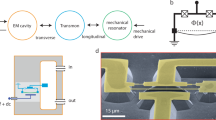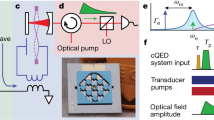Abstract
Open physical systems can be described by effective non-Hermitian Hamiltonians that characterize the gain or loss of energy or particle numbers from the system. Experimental realization of optical1,2,3,4,5,6,7 and mechanical8,9,10,11,12,13 non-Hermitian systems has been reported, demonstrating functionalities such as lasing14,15,16, topological features7,17,18,19, optimal energy transfer20,21 and enhanced sensing22,23. Such realizations have been limited to classical (wave) systems in which only the amplitude information, not the phase, is measured. Thus, the effects of a systems’s proximity to an exceptional point—a degeneracy of such non-Hermitian Hamiltonians where the eigenvalues and corresponding eigenmodes coalesce24,25,26,27,28,29—on its quantum evolution remain unexplored. Here, we use post-selection on a three-level superconducting transmon circuit to carry out quantum state tomography of a single dissipative qubit in the vicinity of its exceptional point. We observe the spacetime reflection symmetry-breaking transition30,31 at zero detuning, decoherence enhancement at finite detuning and a quantum signature of the exceptional point in the qubit relaxation state. Our experiments show phenomena associated with non-Hermitian physics such as non-orthogonality of eigenstates in a fully quantum regime, which could provide a route to the exploration and harnessing of exceptional point degeneracies for quantum information processing.
This is a preview of subscription content, access via your institution
Access options
Access Nature and 54 other Nature Portfolio journals
Get Nature+, our best-value online-access subscription
$29.99 / 30 days
cancel any time
Subscribe to this journal
Receive 12 print issues and online access
$209.00 per year
only $17.42 per issue
Buy this article
- Purchase on Springer Link
- Instant access to full article PDF
Prices may be subject to local taxes which are calculated during checkout




Similar content being viewed by others
Data availability
The data that support the plots within this paper and other findings of this study are available from K.W.M. on reasonable request.
References
Rüter, C. E. et al. Observation of parity–time symmetry in optics. Nat. Phys. 6, 192–195 (2010).
Regensburger, A. et al. Parity–time synthetic photonic lattices. Nature 488, 167–171 (2012).
Hodaei, H., Miri, M.-A., Heinrich, M., Christodoulides, D. N. & Khajavikhan, M. Parity-time-symmetric microring lasers. Science 346, 975–978 (2014).
Feng, L., Wong, Z. J., Ma, R.-M., Wang, Y. & Zhang, X. Single-mode laser by parity-time symmetry breaking. Science 346, 972–975 (2014).
Peng, B. et al. Parity-time-symmetric whispering-gallery microcavities. Nat. Phys. 10, 394–398 (2014).
Feng, L., El-Ganainy, R. & Ge, L. Non-Hermitian photonics based on parity-time symmetry. Nat. Photon. 11, 752–762 (2017).
El-Ganainy, R. et al. Non-Hermitian physics and PT symmetry. Nat. Phys. 14, 11–19 (2018).
Bender, C. M., Berntson, B. K., Parker, D. & Samuel, E. Observation of PT phase transition in a simple mechanical system. Am. J. Phys. 81, 173–179 (2013).
Guo, A. et al. Observation of 𝒫𝒯-symmetry breaking in complex optical potentials. Phys. Rev. Lett. 103, 093902 (2009).
Zeuner, J. M. et al. Observation of a topological transition in the bulk of a non-Hermitian system. Phys. Rev. Lett. 115, 040402 (2015).
Li, J. et al. Observation of parity-time symmetry breaking transitions in a dissipative Floquet system of ultracold atoms. Nat. Commun. 10, 855 (2019).
Weimann, S. et al. Topologically protected bound states in photonic parity-time-symmetric crystals. Nat. Mater. 16, 433–438 (2016).
Xiao, L. et al. Observation of topological edge states in parity-time-symmetric quantum walks. Nat. Phys. 13, 1117–1123 (2017).
Peng, B. et al. Loss-induced suppression and revival of lasing. Science 346, 328–332 (2014).
Miao, P. et al. Orbital angular momentum microlaser. Science 353, 464–467 (2016).
Wong, Z. J. et al. Lasing and anti-lasing in a single cavity. Nat. Photon. 10, 796–801 (2016).
Wang, Z., Chong, Y., Joannopoulos, J. D. & Soljaić, M. Observation of unidirectional backscattering-immune topological electromagnetic states. Nature 461, 772–775 (2009).
Rechtsman, M. C. et al. Photonic Floquet topological insulators. Nature 496, 196–200 (2013).
Chang, L. et al. Parity–time symmetry and variable optical isolation in active–passive-coupled microresonators. Nat. Photon. 8, 524–529 (2014).
Xu, H., Mason, D., Jiang, L. & Harris, J. Topological energy transfer in an optomechanical system with exceptional points. Nature 537, 80–83 (2016).
Assawaworrarit, S., Yu, X. & Fan, S. Robust wireless power transfer using a nonlinear parity–time-symmetric circuit. Nature 546, 387–390 (2017).
Hodaei, H. et al. Enhanced sensitivity at higher-order exceptional points. Nature 548, 187–191 (2017).
Chen, W., Kaya Özdemir, S., Zhao, G., Wiersig, J. & Yang, L. Exceptional points enhance sensing in an optical microcavity. Nature 548, 192–196 (2017).
Doppler, J. et al. Dynamically encircling an exceptional point for asymmetric mode switching. Nature 537, 76–79 (2016).
Zhen, B. et al. Spawning rings of exceptional points out of Dirac cones. Nature 525, 354–358 (2015).
Gao, T. et al. Observation of non-Hermitian degeneracies in a chaotic exciton-polariton billiard. Nature 526, 554–558 (2015).
Kato, T. Perturbation Theory for Linear Operators (Springer, 1995).
Heiss, W. D. The physics of exceptional points. J. Phys. A 45, 444016 (2012).
Zhang, D., Luo, X.-Q., Wang, Y.-P., Li, T.-F. & You, J. Q. Observation of the exceptional point in cavity magnon-polaritons. Nat. Commun. 8, 1368 (2017).
Bender, C. M. & Boettcher, S. Real spectra in non-Hermitian Hamiltonians having PT symmetry. Phys. Rev. Lett. 80, 5243–5246 (1998).
Mostafazadeh, A. Pseudo-Hermitian representation of quantum mechanics. Int. J. Geom. Methods M 7, 1191–1306 (2010).
Dalibard, J., Castin, Y. & Mølmer, K. Wave-function approach to dissipative processes in quantum optics. Phys. Rev. Lett. 68, 580–583 (1992).
Lau, H.-K. & Clerk, A. A. Fundamental limits and non-reciprocal approaches in non-Hermitian quantum sensing. Nat. Commun. 9, 4320 (2018).
Partanen, M. et al. Optimized heat transfer at exceptional points in quantum circuits. Preprint at https://arxiv.org/abs/1812.02683 (2018).
Wu, Y. et al. Observation of parity-time symmetry breaking in a single-spin system. Science 364, 878–880 (2019).
Koch, J. et al. Charge-insensitive qubit design derived from the Cooper pair box. Phys. Rev. A 76, 042319 (2007).
Paik, H. et al. Observation of high coherence in Josephson junction qubits measured in a three-dimensional circuit QED architecture. Phys. Rev. Lett. 107, 240501 (2011).
Wallraff, A. et al. Approaching unit visibility for control of a superconducting qubit with dispersive readout. Phys. Rev. Lett. 95, 060501 (2005).
Steffen, M. et al. Measurement of the entanglement of two superconducting qubits via state tomography. Science 313, 1423–1425 (2006).
Castellanos-Beltran, M. A., Irwin, K. D., Hilton, G. C., Vale, L. R. & Lehnert, K. W. Amplification and squeezing of quantum noise with a tunable Josephson metamaterial. Nat. Phys. 4, 929–931 (2008).
Hatridge, M., Vijay, R., Slichter, D. H., Clarke, J. & Siddiqi, I. Dispersive magnetometry with a quantum limited SQUID parametric amplifier. Phys. Rev. B 83, 134501 (2011).
Jacobs, K. Quantum Measurement Theory and its Applications (Cambridge University Press, 2014).
Wiseman, H. & Milburn, G. Quantum Measurement and Control (Cambridge University Press, 2010).
Carmichael, H. J., Lane, A. S. & Walls, D. F. Resonance fluorescence from an atom in a squeezed vacuum. Phys. Rev. Lett. 58, 2539–2542 (1987).
Wiersig, J. Enhancing the sensitivity of frequency and energy splitting detection by using exceptional points: application to microcavity sensors for single-particle detection. Phys. Rev. Lett. 112, 203901 (2014).
Chen, C., Jin, L. & Liu, R.-B. Sensitivity of parameter estimation near the exceptional point of a non-Hermitian system. New J. Phys. 21, 083002 (2019).
Zhang, M. et al. Quantum noise theory of exceptional point sensors. Preprint at https://arxiv.org/abs/1805.12001 (2018).
Cramér, H. Mathematical Methods of Statistics (Princeton University Press, 1946).
Bures, D. An extension of Kakutani’s theorem on infinite product measures to the tensor product of semifinite w*-algebras. T. Am. Math. Soc. 135, 199–212 (1969).
Jordan, A. N., Martnez-Rincón, J. & Howell, J. C. Technical advantages for weak-value amplification: when less is more. Phys. Rev. X 4, 011031 (2014).
Acknowledgements
We thank P. M. Harrington for preliminary contributions, D. Tan for sample fabrication and K. Mølmer and C. Bender for discussions. K.W.M. acknowledges research support from the NSF (grant nos. PHY-1607156 and PHY-1752844 (CAREER)), and Y.N.J. acknowledges NSF grant no. DMR-1054020 (CAREER). This research used facilities at the Institute of Materials Science and Engineering at Washington University.
Author information
Authors and Affiliations
Contributions
K.W.M., M.N. and Y.N.J. conceived the project. K.W.M., M.A. and M.N. performed the experiments and analysed the data. Y.N.J. provided theory support. K.W.M., M.N. and Y.N.J. wrote the manuscript.
Corresponding authors
Ethics declarations
Competing interests
The authors declare no competing interests.
Additional information
Publisher’s note: Springer Nature remains neutral with regard to jurisdictional claims in published maps and institutional affiliations.
Supplementary information
Supplementary Information
Supplementary Information.
Rights and permissions
About this article
Cite this article
Naghiloo, M., Abbasi, M., Joglekar, Y.N. et al. Quantum state tomography across the exceptional point in a single dissipative qubit. Nat. Phys. 15, 1232–1236 (2019). https://doi.org/10.1038/s41567-019-0652-z
Received:
Accepted:
Published:
Issue Date:
DOI: https://doi.org/10.1038/s41567-019-0652-z
This article is cited by
-
Quantum simulation of the bosonic Kitaev chain
Nature Communications (2024)
-
Statics and dynamics of non-Hermitian many-body localization
Communications Physics (2024)
-
Dynamically crossing diabolic points while encircling exceptional curves: A programmable symmetric-asymmetric multimode switch
Nature Communications (2023)
-
Theoretical and experimental characterization of non-Markovian anti-parity-time systems
Communications Physics (2023)
-
The effect of thermal photons on exceptional points in coupled resonators
Scientific Reports (2023)



